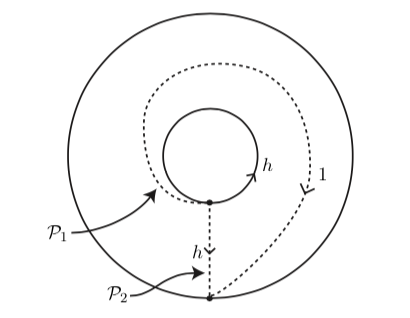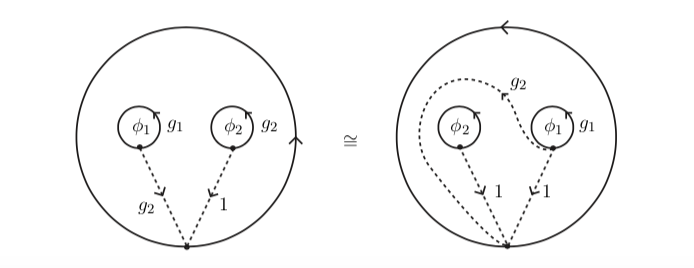In d-dimensional topological field theory one begins with a category S whose objects are oriented (d − 1)-manifolds and whose morphisms are oriented cobordisms. Physicists say that a theory admits a group G as a global symmetry group if G acts on the vector space associated to each (d−1)-manifold, and the linear operator associated to each cobordism is a G-equivariant map. When we have such a “global” symmetry group G we can ask whether the symmetry can be “gauged”, i.e., whether elements of G can be applied “independently” – in some sense – at each point of space-time. Mathematically the process of “gauging” has a very elegant description: it amounts to extending the field theory functor from the category S to the category SG whose objects are (d − 1)-manifolds equipped with a principal G-bundle, and whose morphisms are cobordisms with a G-bundle. We regard S as a subcategory of SG by equipping each (d − 1)-manifold S with the trivial G-bundle S × G. In SG the group of automorphisms of the trivial bundle S × G contains G, and so in a gauged theory G acts on the state space H(S): this should be the original “global” action of G. But the gauged theory has a state space H(S,P) for each G-bundle P on S: if P is non-trivial one calls H(S,P) a “twisted sector” of the theory. In the case d = 2, when S = S1 we have the bundle Pg → S1 obtained by attaching the ends of [0,2π] × G via multiplication by g. Any bundle is isomorphic to one of these, and Pg is isomorphic to Pg‘ iff g′ is conjugate to g. But note that the state space depends on the bundle and not just its isomorphism class, so we have a twisted sector state space Cg = H(S,Pg) labelled by a group element g rather than by a conjugacy class.
We shall call a theory defined on the category SG a G-equivariant Topological Field Theory (TFT). It is important to distinguish the equivariant theory from the corresponding “gauged theory”. In physics, the equivariant theory is obtained by coupling to nondynamical background gauge fields, while the gauged theory is obtained by “summing” over those gauge fields in the path integral.
An alternative and equivalent viewpoint which is especially useful in the two-dimensional case is that SG is the category whose objects are oriented (d − 1)-manifolds S equipped with a map p : S → BG, where BG is the classifying space of G. In this viewpoint we have a bundle over the space Map(S,BG) whose fibre at p is Hp. To say that Hp depends only on the G-bundle p∗EG on S pulled back from the universal G-bundle EG on BG by p is the same as to say that the bundle on Map(S,BG) is equipped with a flat connection allowing us to identify the fibres at points in the same connected component by parallel transport; for the set of bundle isomorphisms p∗0EG → p∗1EG is the same as the set of homotopy classes of paths from p0 to p1. When S = S1 the connected components of the space of maps correspond to the conjugacy classes in G: each bundle Pg corresponds to a specific point pg in the mapping space, and a group element h defines a specific path from pg to phgh−1 .
G-equivariant topological field theories are examples of “homotopy topological field theories”. Using Vladimir Turaev‘s two main results: first, an attractive generalization of the theorem that a two-dimensional TFT “is” a commutative Frobenius algebra, and, secondly, a classification of the ways of gauging a given global G-symmetry of a semisimple TFT.

Definition of the product in the G-equivariant closed theory. The heavy dot is the basepoint on S1. To specify the morphism unambiguously we must indicate consistent holonomies along a set of curves whose complement consists of simply connected pieces. These holonomies are always along paths between points where by definition the fibre is G. This means that the product is not commutative. We need to fix a convention for holonomies of a composition of curves, i.e., whether we are using left or right path-ordering. We will take h(γ1 ◦ γ2) = h(γ1) · h(γ2).
A G-equivariant TFT gives us for each element g ∈ G a vector space Cg, associated to the circle equipped with the bundle pg whose holonomy is g. The usual pair-of-pants cobordism, equipped with the evident G-bundle which restricts to pg1 and pg2 on the two incoming circles, and to pg1g2 on the outgoing circle, induces a product
Cg1 ⊗ Cg2 → Cg1g2 —– (1)

making C := ⊕g∈GCg into a G-graded algebra. Also there is a trace θ: C1 → C defined by the disk diagram with one ingoing circle. The holonomy around the boundary of the disk must be 1. Making the standard assumption that the cylinder corresponds to the unit operator we obtain a non-degenerate pairing
Cg ⊗ Cg−1 → C
A new element in the equivariant theory is that G acts as an automorphism group on C. That is, there is a homomorphism α : G → Aut(C) such that
αh : Cg → Chgh−1 —– (2)
Diagramatically, αh is defined by the surface in the immediately above figure. Now let us note some properties of α. First, if φ ∈ Ch then αh(φ) = φ. The reason for this is diagrammatically in the below figure.

If the holonomy along path P2 is h then the holonomy along path P1 is 1. However, a Dehn twist around the inner circle maps P1 into P2. Therefore, αh(φ) = α1(φ) = φ, if φ ∈ Ch.
Next, while C is not commutative, it is “twisted-commutative” in the following sense. If φ1 ∈ Cg1 and φ2 ∈ Cg2 then
αg2 (φ1)φ2 = φ2φ1 —– (3)
The necessity of this condition is illustrated in the figure below.

The trace of the identity map of Cg is the partition function of the theory on a torus with the bundle with holonomy (g,1). Cutting the torus the other way, we see that this is the trace of αg on C1. Similarly, by considering the torus with a bundle with holonomy (g,h), where g and h are two commuting elements of G, we see that the trace of αg on Ch is the trace of αh on Cg−1. But we need a strengthening of this property. Even when g and h do not commute we can form a bundle with holonomy (g,h) on a torus with one hole, around which the holonomy will be c = hgh−1g−1. We can cut this torus along either of its generating circles to get a cobordism operator from Cc ⊗ Ch to Ch or from Cg−1 ⊗ Cc to Cg−1. If ψ ∈ Chgh−1g−1. Let us introduce two linear transformations Lψ, Rψ associated to left- and right-multiplication by ψ. On the one hand, Lψαg : φ ↦ ψαg(φ) is a map Ch → Ch. On the other hand Rψαh : φ ↦ αh(φ)ψ is a map Cg−1 → Cg−1. The last sewing condition states that these two endomorphisms must have equal traces:
TrCh Lψαg = TrCg−1 Rψαh —– (4)


(4) was taken by Turaev as one of his axioms. It can, however, be reexpressed in a way that we shall find more convenient. Let ∆g ∈ Cg ⊗ Cg−1 be the “duality” element corresponding to the identity cobordism of (S1,Pg) with both ends regarded as outgoing. We have ∆g = ∑ξi ⊗ ξi, where ξi and ξi run through dual bases of Cg and Cg−1. Let us also write
∆h = ∑ηi ⊗ ηi ∈ Ch ⊗ Ch−1. Then (4) is easily seen to be equivalent to
∑αh(ξi)ξi = ∑ηiαg(ηi) —– (5)
in which both sides are elements of Chgh−1g−1.
